![]()
![]()
![]()
Use LEFT and RIGHT arrow keys to navigate between flashcards;
Use UP and DOWN arrow keys to flip the card;
H to show hint;
A reads text to speech;
30 Cards in this Set
- Front
- Back
|
What are the three components of the cell theory? |
1. All organisms are composed of one or more cells. 2. The cell is the smallest structural and functional unit of life. 3. Cells arise only from growth and division of pre-existing cells. |
|
|
What are the two major cell types? |
Eukaryotic and prokaryotic cells |
|
|
What are the similarities and differences between eukaryotic and prokaryotic cells? |
Similarities: Plasma membrane, DNA, cytoplasm, cytoskeleton (structure + transport) Differences: Separation of DNA and cytoplasm by nuclear envelope (EU) Presence of organelles (EU) Motor proteins (EU) EU larger than PRO PRO has one circular DNA, EU has many linear DNA |
|
|
Explain why eukaryotic cells are bigger than prokaryotic cells. |
Surface to volume ratios determine size of cells. The greater the volume, the smaller the surface, therefore creating a higher demand for energy that cannot be met. Thanks to endomembrane system, EU can meet needs but PRO cannot. Therefore PRO must remain small (or it will die). |
|
|
What are key characteristics of prokaryotic cells? |
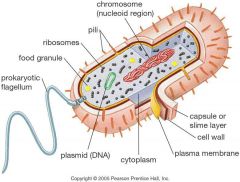
No nucleus or membrane-bound organelles Unbound circular DNA Ribosomes Capsule Cell wall Plasma membrane (for cell respiration/photosynthesis) Flagella and pili |
|
|
Name all parts of the nucleus. |
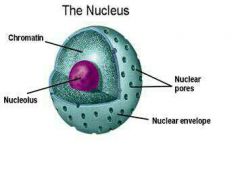
Nucleus - contains genes
Nuclear envelope - encloses nucleus *(double bilipid layer membrane)*
Nuclear pore complex - controls trafficking activity
Chromatin - DNA and genetic material (condensed chromatin are chromosomes)
Nucleolus - inside nucleus and is site of ribosomal RNA (rRNA) synthesis |
|
|
What are ribosomes, where can they be found and what do they do? |
Ribosomes are particles that carry out protein synthesis. They can be free (cytosol) or bound (on outer surface of ER or NE) |
|
|
Define "endomembrane system". What is part of this system? |
Collection of interrelated internal membranous sacs called organelles = very high and good StV ratio. Functions include: regulation of protein traffic and metabolic functions. NE, ER, GA, LYSO, VESI, PM |
|
|
The _________ ER is studded with _________ and creates proteins. It is attached to the ______. The _________ ER synthesizes _______ and breaks down toxic substances. |
Rough; ribosomes; nucleus; smooth; lipids |
|
|
Describe the trek of proteins through Golgi Apparatus. |
Proteins enter cis-face where they are chemically modified/tagged and then are sorted into transport vesicles. They exit from trans-face to either be part of PM or secreted from cell. |
|
|
Lysosomes have ________ _______ that help digest macromolecules. The act of recycling the cell's organelles is called ________. The lysosome is also involved in ______, which is the engulfment and digestion of another cell or a bigger molcule. |
Hydrolytic enzymes, autophagy, phagocytosis |
|
|
Difference(s) between exocytosis and endocytosis? |
Exocytosis = secretion ; endocytosis = invagination |
|
|
Name the function of the mitochondrion, its characteristics and its parts. |
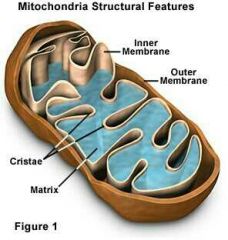
Cellular respiration (breakdown of glucose to create ATP) Has its own DNA and uses own ribosomes to create proteins It has a double bilipid layer membrane. From out to in, its parts are: outer membrane, cristae (folds), inner membrane and matrix. |
|
|
The cytoskeleton is a ________ structure, built from _______, _________ & __________. Its functions include: (4) |
Supportive; microtubules, intermediate filaments, microfilaments; Support and shape cells, interaction with motor protein (motility), monorail for vesicle trafficking and regulation of biochemical activity. |
|
|
What is the microtubule and what are its functions? |
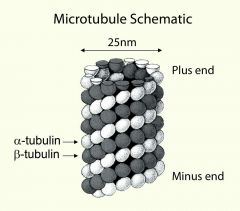
The microtubule is made of tubulin organized in a circular helix and has + (a) and - (b) ends. It functions as part of the cell monorail and plays a role in mitosis and movement of the cell. |
|
|
What are intermediate filaments and what are they used for? |
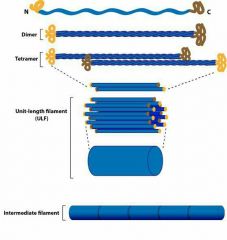
Intermediate filaments are groups of weaved keratin that support the cell structure. They have immense strength and are tube-like. |
|
|
What are microfilaments and what do they do? |

Microfilaments have positive and negative ends and are made up of braided actin particles. They are responsible for much of the action and movement in the cell. |
|
|
Microtubules grow out of ________. Plant cells have _______ than 1 of them. Animal cells generally have _________ of them. They aid in _______, and are found ____________ to each other. |

Centrioles, more, 2, mitosis, perpendicular |
|
|
Explain the function and structure of the kinesin molecule. |

The kinesin molecule is a motor protein that walks along a microtubule in order to transport vesicles around the cell. The alpha helixes of the protein are connected to the vesicle while the beta sheets walk along the microtubule. |
|
|
Describe the structure of a eukaryotic and prokaryotic flagellum. |
The prokaryotic flagellum is composed of flagellin, which propels the bacteria in any direction. The eukaryotic flagellum is made of microtubules organized in a 9+2 pattern (9 pairs + 2 extra in the middle). It is composed of the dynein protein, which makes a whip-like motion and is only found on sperm. |
|
|
Describe cilia. |
Cilia are smaller flagellums located in the digestive and respiratory tracks. They move things along in a streaming fashion by beating around. |
|
|
These organelles convert hydrogen peroxide to water. They use _______ to remove oxygen. |
Peroxisomes, catalase |
|
|
The chloroplast is the site for __________. They have their own _______ and create proteins from their ___________. They have a _________ lipid bilayer membrane and have _________ organized into grana for __________. |
Photosynthesis, dna, ribosomes, double, thylakoids, photosynthesis |
|
|
What are the three types of vacuoles? |
Food vacuoles: formed by phagocytosis (storage) Contractile vacuoles: pump excess water out of cells Central vacuoles: hold organic compounds and water (can also act as lysosomes and hold pigments) |
|
|
What are the parts of the cell wall and what are its functions? |
The cell wall is made of cellulose or chitin (EU) peptidoglycan (PRO). It has plasmodesmata, which are pores or channels that allow chemicals to move back and forth. It provides support and protection. |
|
|
What are the components of the animal cell surface? |
The surface of an animal cell is composed of cell surface molecules with functions in contact, communication & organization: Cell adhesion molecules Cell junctions Extracellular matrix |
|
|
What are the roles of cell adhesion molecules? Name an example. |
They maintain body form & function, attach and detach during development, recognise cells with "tags" and is an adhesion site for pathogens. Ie glycoprotein |
|
|
Name the three cell junctions and their functions. |
Tight junctions prevent leakage of extracellular fluid by sealing cells together (ie stomach cells) Anchoring junctions fasten cells together in strong sheets using intermediate filaments (ie muscle/skeletal tissue) Gap junctions provide cytoplasmic channels between adjacent cells. |
|
|
Describe the functions and components of the extracellular matrix. |
The EM is used as a support and base structure for tissues and allows proteins on the PM to attach via integrin (binding protein) and fibronectin, ******** |
|
|
Describe the functions and components of the extracellular matrix. |
The EM is used as a support and base structure for tissues and allows proteins on the PM to attach via integrin (binding protein) and fibronectin, ******** |

